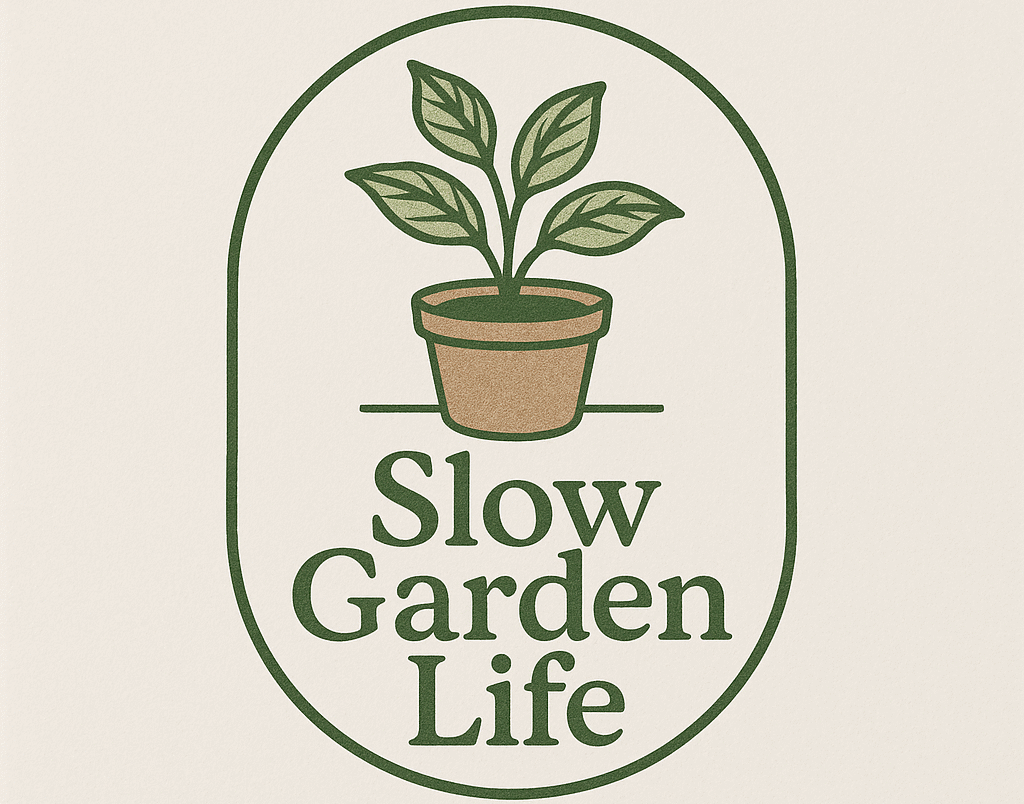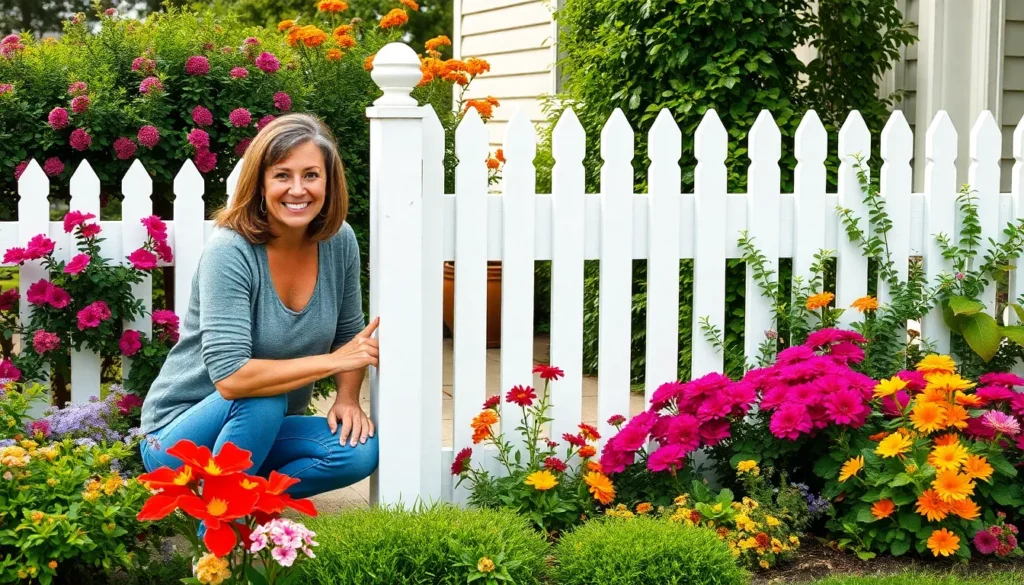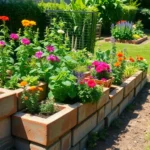Your front garden’s first impression matters more than you might think. The right fencing doesn’t just mark property boundaries – it transforms your home’s entire curb appeal while providing essential privacy and security. We’ve seen countless homeowners struggle with choosing the perfect front garden fence that balances style functionality and budget.
From classic picket fences that scream timeless charm to sleek modern panels that make bold statements we’ll explore fence ideas that work for every home style and preference. Whether you’re dealing with a compact urban front yard or sprawling suburban industry there’s a fencing solution that’ll elevate your property’s value and visual impact.
We’ll jump into materials costs maintenance requirements and design considerations that’ll help you make the smartest choice for your exact needs. Ready to discover how the right front garden fence can completely transform your home’s exterior?
Traditional Wooden Fence Ideas for Front Garden Appeal
Traditional wooden fences remain the gold standard for front garden appeal, offering timeless charm that complements virtually any architectural style. We’ve found that wooden fencing creates an inviting entrance while establishing clear property boundaries with natural warmth.
Classic Picket Fencing Options
White picket fences transform ordinary front yards into picture-perfect settings reminiscent of classic American homes. We recommend heights between 3 to 4 feet for optimal curb appeal without blocking sightlines to your home’s facade. Traditional picket spacing ranges from 2 to 4 inches apart, allowing glimpses of your garden while maintaining definition.
Scalloped picket designs add visual interest through curved top rails that create gentle waves across your fence line. These elegant variations work exceptionally well with Victorian or cottage-style homes where decorative elements enhance architectural character. Pointed pickets offer the most traditional appearance, while rounded tops provide a softer, more welcoming feel.
Board and batten combinations integrate wider boards with narrow battens for a sophisticated twist on classic picket styling. We’ve seen homeowners achieve stunning results by alternating board widths or incorporating decorative post caps that match their home’s exterior details.
Cedar and Pine Material Choices
Cedar fencing delivers superior durability and natural weather resistance, making it our top recommendation for front garden applications. Western red cedar contains natural oils that repel insects and resist moisture damage for 15 to 20 years without treatment. The wood’s straight grain and consistent color create a premium appearance that ages gracefully to an attractive silver-gray patina.
Pine options provide budget-friendly alternatives that accept stains and paints exceptionally well. Pressure-treated pine costs approximately 30% less than cedar while offering 10 to 15 years of service life with proper maintenance. Southern yellow pine features dense grain patterns that hold fasteners securely and resist warping in varying weather conditions.
Redwood selections offer the ultimate in natural beauty and longevity, though prices typically run 40% higher than cedar alternatives. The wood’s natural tannins provide excellent moisture resistance while maintaining rich color variations that enhance any front garden setting.
Staining and Painting Considerations
Semi-transparent stains preserve wood grain visibility while providing UV protection and moisture resistance for 3 to 5 years between applications. We recommend oil-based formulations for cedar and water-based options for pine to achieve optimal penetration and durability. Popular colors include natural cedar, honey gold, and weathered gray tones that complement traditional home exteriors.
Solid color stains offer paint-like coverage with superior wood protection, lasting 5 to 7 years in typical weather conditions. These products work particularly well on pine fencing where you want consistent color without visible grain patterns. Choose colors that coordinate with your home’s trim or siding for a cohesive appearance.
Traditional paint applications create the classic white picket fence look that never goes out of style. Quality exterior latex paint provides 7 to 10 years of protection when applied over properly primed surfaces. We suggest using semi-gloss or satin finishes that resist dirt accumulation and clean easily with routine maintenance.
Modern Metal Fencing Solutions for Contemporary Homes

Moving beyond traditional wooden options, metal fencing delivers sleek sophistication perfect for today’s architectural styles. Contemporary homeowners increasingly choose metal answers for their durability and minimal maintenance requirements.
Aluminum Panel Designs
Aluminum fences offer exceptional versatility for modern front gardens while maintaining lightweight construction benefits. Clean, flat panels create streamlined aesthetics that complement contemporary home designs beautifully. Installation becomes significantly easier compared to heavier materials like steel or iron, reducing labor costs and project timelines.
Sleek horizontal configurations work particularly well with minimalist architecture, creating visual continuity across your property line. Vertical slat arrangements provide alternative styling options while maintaining the same contemporary appeal. Durability remains outstanding since aluminum naturally resists corrosion without requiring extensive protective treatments.
Steel and Iron Decorative Options
Steel and iron fencing answers provide robust construction with extensive decorative possibilities for discerning homeowners. Ornate patterns can enhance traditional home styles, while minimalist linear designs suit ultra-modern properties perfectly. Weather resistance makes both materials excellent long-term investments for front garden applications.
Custom fabrication allows unique design elements that reflect your personal style preferences. Decorative metalwork can incorporate geometric patterns, artistic scrollwork, or architectural motifs. Both materials withstand harsh weather conditions while maintaining structural integrity over decades of use.
Powder Coating and Finish Varieties
Powder coating technology revolutionizes metal fence protection while expanding aesthetic possibilities significantly. Corrosion resistance improves dramatically compared to traditional paint applications, extending fence lifespan considerably. Color matching becomes effortless with extensive finish options available in the market.
| Finish Type | Durability | Aesthetic Appeal | Maintenance Level |
|---|---|---|---|
| Matte | High | Subtle, modern | Low |
| Gloss | Very High | Bold, reflective | Low |
| Textured | Highest | Unique, tactile | Very Low |
Mixed material combinations create stunning visual interest by pairing metal frameworks with wood or stone accents. Horizontal metal configurations deliver distinctly modern appearances that photograph beautifully for social media. These approaches add warmth and texture while maintaining the structural benefits of metal construction.
Natural Stone and Brick Fencing Concepts
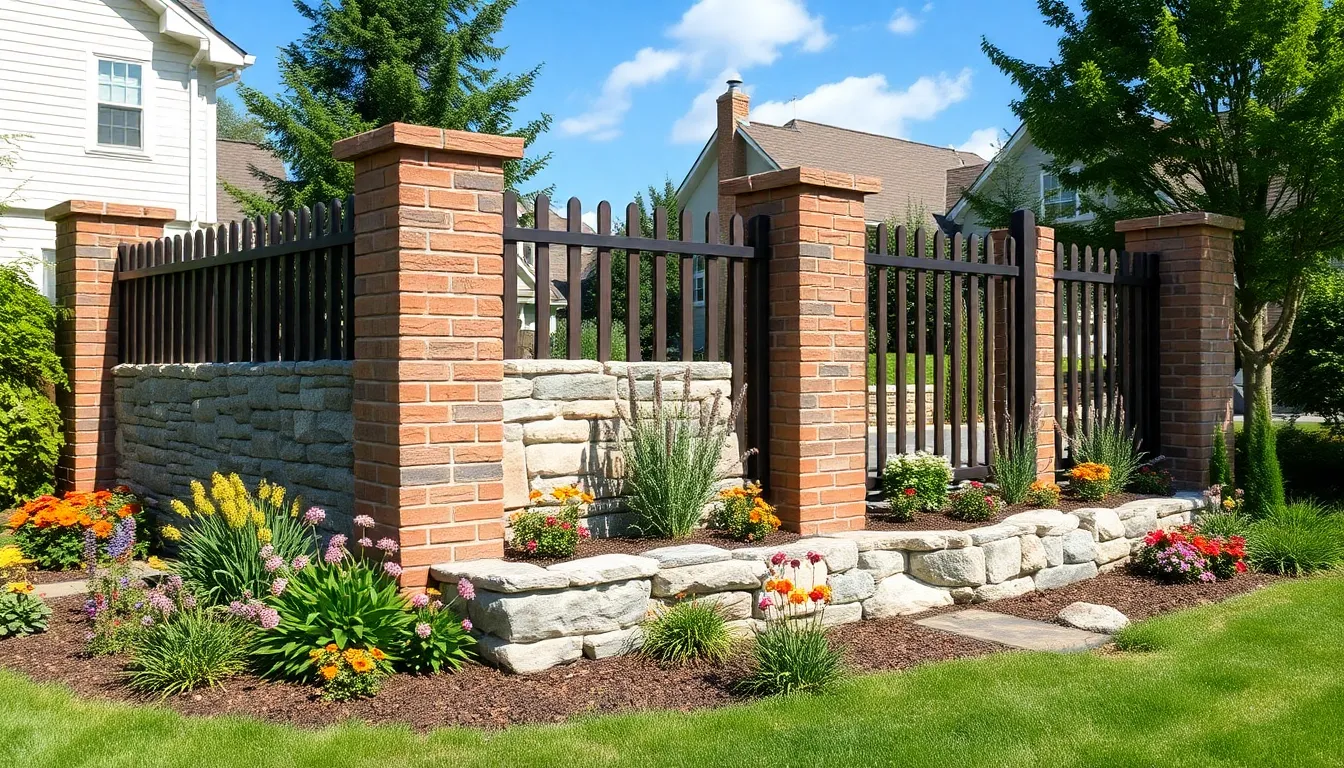
Natural stone and brick materials bring timeless elegance to front garden fencing while offering exceptional durability and architectural character.
Dry Stone Wall Construction
Dry stone wall construction creates stunning rustic boundaries without requiring mortar or cement. We stack carefully selected stones using traditional techniques that have endured for centuries, allowing natural settling and flexibility during temperature changes. This method works exceptionally well for rural or cottage style homes where natural aesthetics take priority over formal design elements.
Stones typically range from 6 to 18 inches in length and require proper foundation preparation to ensure structural integrity. We recommend limestone, sandstone, or fieldstone varieties that complement your region’s natural industry. The construction process involves layering stones from largest to smallest, creating a stable interlocking system that can last decades with minimal maintenance.
Brick Pillar Integration
Brick pillar integration adds sophisticated architectural elements while providing structural support for various fence materials. We position these pillars at regular intervals of 6 to 8 feet to create rhythmic visual patterns that enhance curb appeal. The pillars typically measure 18 to 24 inches square and rise 4 to 6 feet above ground level, depending on your privacy requirements.
Traditional red brick offers classic appeal, while contemporary options include charcoal, buff, or whitewashed varieties that coordinate with modern home exteriors. We often incorporate decorative caps made from natural stone or precast concrete to protect the pillar tops from weather damage. These pillars can support wooden panels, metal railings, or even serve as standalone decorative elements with integrated lighting fixtures.
Mixed Material Combinations
Mixed material combinations create ever-changing visual interest by pairing different textures and heights throughout your front garden fence design. We frequently combine short stone walls measuring 2 to 3 feet high with taller wooden sections reaching 5 to 6 feet, creating layered privacy zones that feel less imposing than solid barriers.
Wood and stone partnerships work particularly well, with cedar or pressure treated lumber complementing natural stone foundations. Metal and brick combinations offer contemporary appeal, featuring sleek aluminum or steel railings between substantial brick pillars. We’ve seen homeowners achieve stunning results by alternating materials in 8 to 12 foot sections, creating rhythm and preventing monotonous fence lines that lack personality.
Living Fence Ideas Using Plants and Hedges

Living fences transform front gardens into natural barriers that grow more beautiful over time. We’ll explore plant based options that provide privacy while improving your home’s aesthetic appeal.
Evergreen Hedge Varieties
Evergreen hedges deliver year round foliage and maintain their neat appearance through regular trimming. Boxwood stands out as our top recommendation because it grows slowly and responds well to shaping, reaching mature heights of 3 to 6 feet. Yew varieties offer excellent density and can tolerate heavy pruning, making them perfect for formal garden designs.
These hardy plants require minimal maintenance once established and provide consistent screening regardless of season. Boxwood hedges typically cost $15 to $25 per linear foot when professionally installed, while yew options range from $20 to $35 per foot. We recommend planting these varieties 18 to 24 inches apart for optimal coverage within 2 to 3 years.
Flowering Shrub Borders
Flowering shrubs create vibrant fence lines that change with the seasons and attract beneficial wildlife. Azaleas bloom in spring with colors ranging from white to deep purple, reaching mature heights of 4 to 8 feet depending on the variety. Rhododendrons offer larger blooms and can grow up to 12 feet tall, creating substantial privacy barriers.
These shrubs work best when planted in staggered rows to create depth and visual interest. We suggest combining early and late blooming varieties to extend the flowering season from March through June. Maintenance involves annual pruning after blooming and regular watering during dry periods.
Bamboo Screen Installation
Bamboo screens provide sustainable fencing that grows quickly and offers excellent privacy coverage. Running bamboo varieties like Golden Bamboo can reach heights of 15 to 20 feet within 3 years, creating dense natural barriers. Clumping bamboo types grow more slowly but stay contained without spreading aggressively.
Installation requires containment barriers for running varieties to prevent unwanted spreading into neighboring properties. We recommend installing root barriers 2 feet deep around the planting area and choosing clumping varieties like Fargesia for front yard applications. Bamboo fencing costs approximately $10 to $20 per linear foot and requires annual thinning to maintain appearance and health.
Composite and Vinyl Fencing Alternatives

We’ve discovered that composite and vinyl fencing answers offer homeowners the perfect blend of beauty and practicality without the ongoing maintenance demands of traditional materials.
Low-Maintenance Material Benefits
Durability becomes our greatest advantage when choosing composite and vinyl fencing options. Both materials resist rot, mold, and insect damage that typically plague wooden fences, ensuring your investment remains protected for decades. Composite fencing combines wood fibers with plastic to create exceptionally strong panels that withstand daily wear and environmental stress.
Cleaning requirements stay minimal with these modern alternatives. We simply need soap and water to maintain their appearance, eliminating the need for annual staining, sealing, or painting that wooden fences demand. Vinyl fencing offers particularly easy maintenance since it doesn’t absorb dirt or grime like porous materials.
Long term savings accumulate significantly because these materials eliminate recurring maintenance costs. While the initial investment may be higher than wood, we avoid expenses for paint, stain, sealers, and frequent repairs over the fence’s lifetime.
Color and Texture Options
Vinyl fencing provides extensive customization with colors ranging from classic white and beige to contemporary grays and earth tones. We can choose from various styles including traditional picket designs and modern large panel configurations that suit different architectural preferences.
Composite materials offer realistic wood textures that closely mimic natural grain patterns without the associated maintenance. These options include cedar, oak, and mahogany appearances that complement both traditional and contemporary home styles.
Color consistency remains stable throughout the fence’s lifespan since both materials resist fading and discoloration. We don’t need to worry about uneven weathering or the patchy appearance that can develop with painted wooden fences over time.
Weather Resistance Features
UV protection comes standard in quality composite and vinyl fencing materials, preventing the sun’s rays from causing fading or structural degradation. These materials are specifically formulated to maintain their color and integrity under constant sun exposure.
Moisture resistance eliminates common problems like warping, swelling, and rot that affect wooden fences. Both vinyl and composite materials are impermeable to water, making them ideal for regions with high humidity or frequent rainfall.
Temperature fluctuations don’t cause damage since these materials are engineered to expand and contract without cracking or splitting. We can confidently install them in climates with extreme seasonal changes without worrying about structural failure or aesthetic deterioration.
Decorative Wire and Mesh Fencing Styles
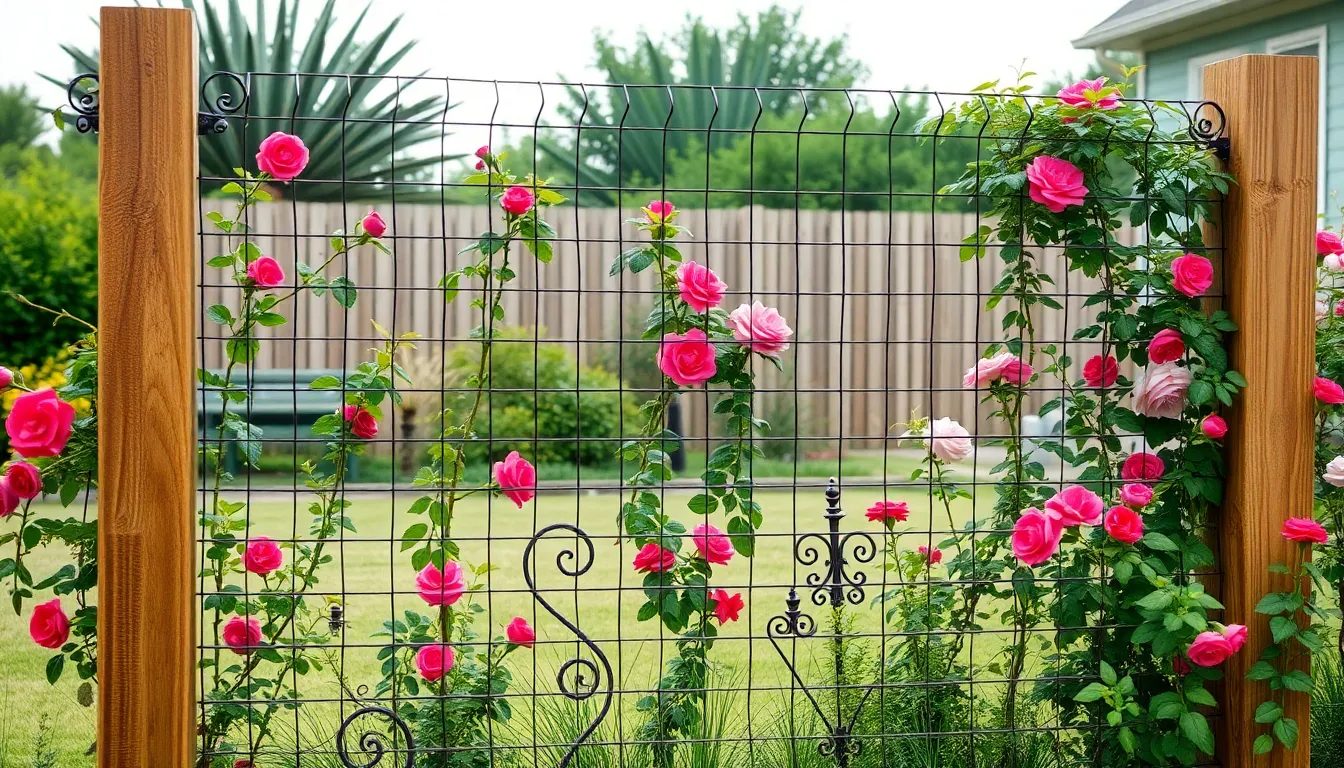
Wire and mesh fencing options bring industrial charm to front gardens while maintaining affordability and functionality. These versatile materials create stunning boundaries that allow light and views to pass through.
Modern Hog Wire Fence
Modern hog wire fencing transforms industrial materials into sophisticated garden boundaries. Wire mesh panels allow plants to grow through naturally, creating a rustic yet contemporary appearance that complements both modern and traditional home styles. Wooden posts frame these panels perfectly, matching other design elements throughout your garden industry.
We recommend selecting wire mesh with 4×4 inch or 6×6 inch openings to accommodate plant growth while maintaining structural integrity. Cedar or pressure treated pine posts provide the best durability when paired with galvanized wire panels. Installation requires spacing posts 6 to 8 feet apart for optimal support and visual balance.
Wrought Iron Inspired Designs
Ornate wrought iron inspired wire fencing adds classical elegance to front garden boundaries. Intricate patterns and decorative scrollwork create timeless appeal while maintaining the practical benefits of wire construction. Black or bronze powder coated finishes enhance the dramatic visual impact of these sophisticated designs.
We suggest incorporating decorative post caps and matching hardware to complete the wrought iron aesthetic. Steel wire panels with ornamental details cost significantly less than solid wrought iron while delivering similar visual impact. Heights between 3 and 5 feet work best for front yard applications without overwhelming smaller garden spaces.
Chain Link Enhancement Ideas
Decorative chain link transformations turn utilitarian fencing into attractive garden features. Vinyl coated chain link in colors like forest green or black creates a more refined appearance than traditional galvanized options. Privacy slats inserted through the mesh provide additional screening while adding color and texture variations.
Vine integration softens chain link’s industrial appearance naturally over time. Climbing roses, clematis, or morning glories grow beautifully through the mesh openings, creating living walls of color and fragrance. We recommend planting vines 2 to 3 feet apart along the fence line for complete coverage within two growing seasons.
Decorative post caps and colored framework elevate standard chain link installations significantly. Aluminum or steel posts with powder coated finishes match home exterior colors perfectly. Solar post cap lights add nighttime illumination while improving the fence’s decorative appeal.
Garden Trellis Integration
Trellis panel integration creates functional art pieces that support climbing plants beautifully. Wooden or metal trellis sections mounted between fence posts provide structured growing surfaces for vines and climbing flowers. These panels add vertical interest while creating lush, vibrant garden displays.
Arbors and arches frame garden entrances charmingly when combined with wire fencing systems. We position these decorative elements at gate openings or property corners to create focal points that welcome visitors. Cedar and redwood trellis materials weather naturally, developing attractive patina over time.
Modular trellis systems allow seasonal customization of your wire fence design. Removable panels let you change plant varieties or adjust privacy levels throughout the year. Galvanized wire backing supports heavier climbing plants like grape vines or wisteria without sagging or structural damage.
Height and Privacy Considerations for Front Yards

Understanding height restrictions and privacy options helps us create front garden fences that meet both aesthetic and functional goals. Most communities limit front yard fencing to maintain neighborhood visibility while still allowing homeowners to define their property boundaries.
Local Zoning Regulation Requirements
Zoning codes typically restrict front yard fences to 3 to 4 feet in height to preserve driver and pedestrian visibility throughout residential neighborhoods. Local authorities establish these height limits to prevent the creation of wall-like barriers that could obstruct sightlines at intersections or driveways.
Permit requirements vary by location and may apply to fences exceeding certain heights or exact materials like wrought iron or stone. We recommend checking with your local building department before installation to avoid costly fines or mandatory removal of non-compliant structures.
Material restrictions often accompany height regulations in many jurisdictions, with some areas prohibiting certain fence types or requiring exact setbacks from sidewalks and property lines. These regulations ensure that front yard fencing contributes positively to neighborhood character while maintaining public safety standards.
Neighbor Relations and Boundary Lines
Communication with adjacent property owners prevents disputes and builds positive relationships before we begin any fencing project. Informing neighbors about our plans, timeline, and design choices demonstrates courtesy and often leads to collaborative answers that benefit both properties.
Boundary line verification protects us from encroachment issues that could result in legal complications or forced fence relocation. Professional surveys or property line markers help ensure our fence installation respects neighboring properties and complies with local setback requirements.
Shared fence agreements can reduce costs when neighbors agree to split expenses for boundary fencing that benefits both properties. These arrangements work particularly well when adjacent homeowners desire similar fence styles and materials for their front yards.
Security Versus Curb Appeal Balance
Security benefits from front yard fencing include clearly defined property boundaries that deter casual trespassers while maintaining the open, welcoming appearance expected in residential neighborhoods. Even shorter fences create psychological barriers that enhance security without appearing fortress-like.
Curb appeal improvements through well-designed fencing can increase property values significantly when the fence style complements our home’s architecture and neighborhood aesthetics. Strategic design choices like decorative post caps, attractive materials, and thoughtful landscaping integration maximize visual impact.
Balanced approaches combine security and beauty through features like decorative pickets with minimal spacing, low stone walls topped with ornamental railings, or mixed material designs that provide definition without blocking views. These answers satisfy both practical needs and neighborhood standards while improving our property’s overall appeal.
Budget-Friendly DIY Fencing Projects
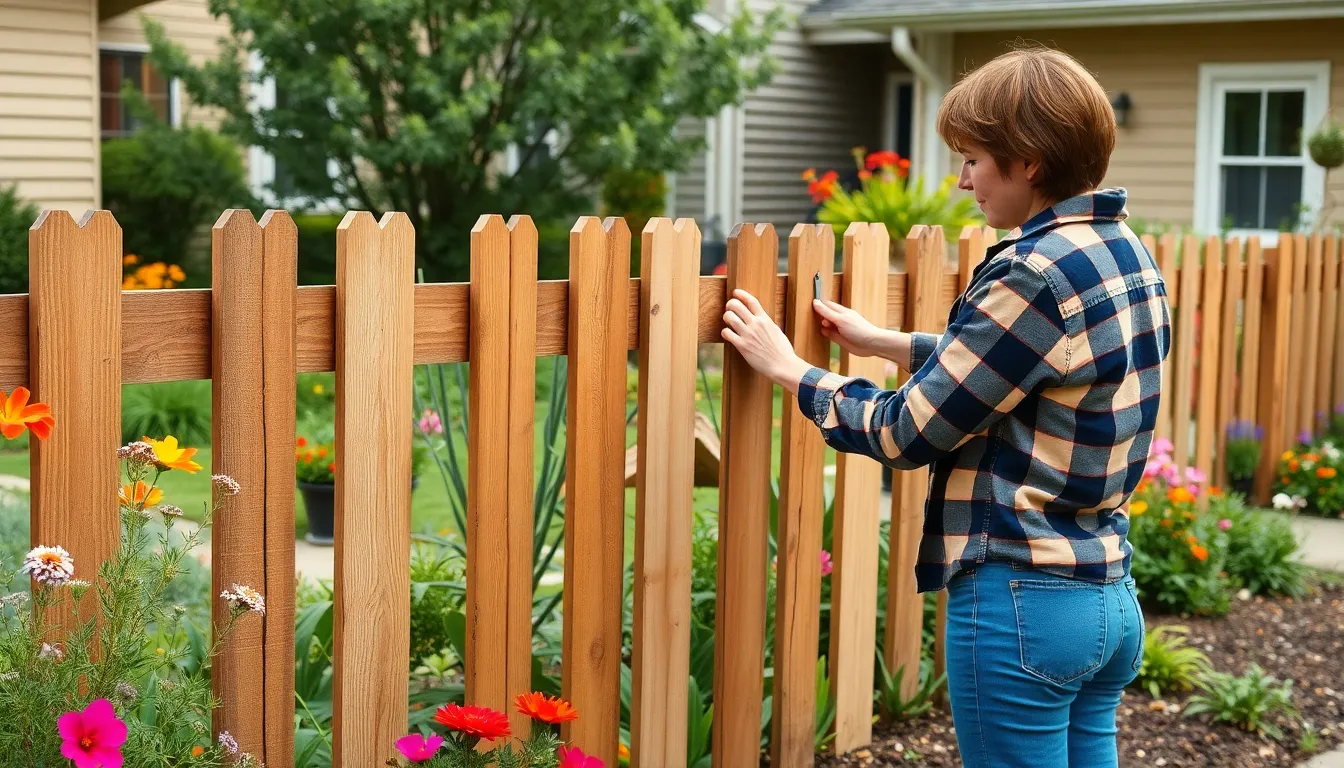
Creating an attractive front garden fence doesn’t require very costly when you embrace smart DIY approaches. We’ve compiled practical answers that combine affordability with impressive results for homeowners ready to tackle their own fencing projects.
Pallet Wood Repurposing Ideas
Pallet wood fence construction transforms discarded shipping materials into charming rustic barriers. Disassembling old pallets provides free lumber that creates unique textured surfaces perfect for cottage style gardens and farmhouse exteriors.
Weathered pallet planks offer natural character that new lumber simply can’t match. Sanding rough edges smooths splinters while preserving the authentic aged appearance that adds instant charm to your property line.
Staining reclaimed pallet wood protects the material from moisture damage while improving its natural grain patterns. Semi transparent stains in cedar or oak tones complement most home exteriors without hiding the wood’s original texture.
Spacing pallet fence boards creates interesting shadow patterns throughout the day while maintaining privacy coverage. Alternating board widths adds visual rhythm that prevents monotonous fence lines from appearing bland or institutional.
Hardware Store Material Answers
Vinyl fencing panels offer low maintenance durability that withstands weather extremes without warping or rotting. Most hardware stores stock white, tan, and gray options that install easily with basic tools and minimal experience.
Chain link fencing provides budget friendly security while allowing air circulation and partial visibility through your garden space. Vinyl coated options in green or black blend better with landscaping than traditional galvanized steel finishes.
Bamboo fencing rolls create sustainable screening that installs quickly over existing chain link or wooden frameworks. These eco friendly materials cost significantly less than solid wood panels while providing excellent privacy coverage.
Garden netting answers involve stapling mesh materials to wooden stakes for temporary seasonal barriers. This approach works perfectly for protecting vegetable gardens from critters while keeping installation costs under $50 for most properties.
Tool Requirements and Installation Tips
Essential tools include a drill, screwdriver, hammer, level, measuring tape, and staple gun for most DIY fencing projects. Post hole diggers speed up installation significantly but can be rented rather than purchased for single use projects.
Concrete post setting ensures stability for fence panels that must withstand wind loads and daily use. Mixing one bag of concrete per post provides adequate support for most residential applications without requiring professional equipment.
Level installation techniques prevent sagging fence lines that look unprofessional and may violate local building codes. Checking each post with a level during installation saves time compared to correcting mistakes after concrete sets.
Following manufacturer instructions prevents warranty voiding mistakes that could cost hundreds in replacement materials. Each fencing material has exact spacing requirements and fastener recommendations that ensure long term performance.
Eco-Friendly and Sustainable Fencing Options
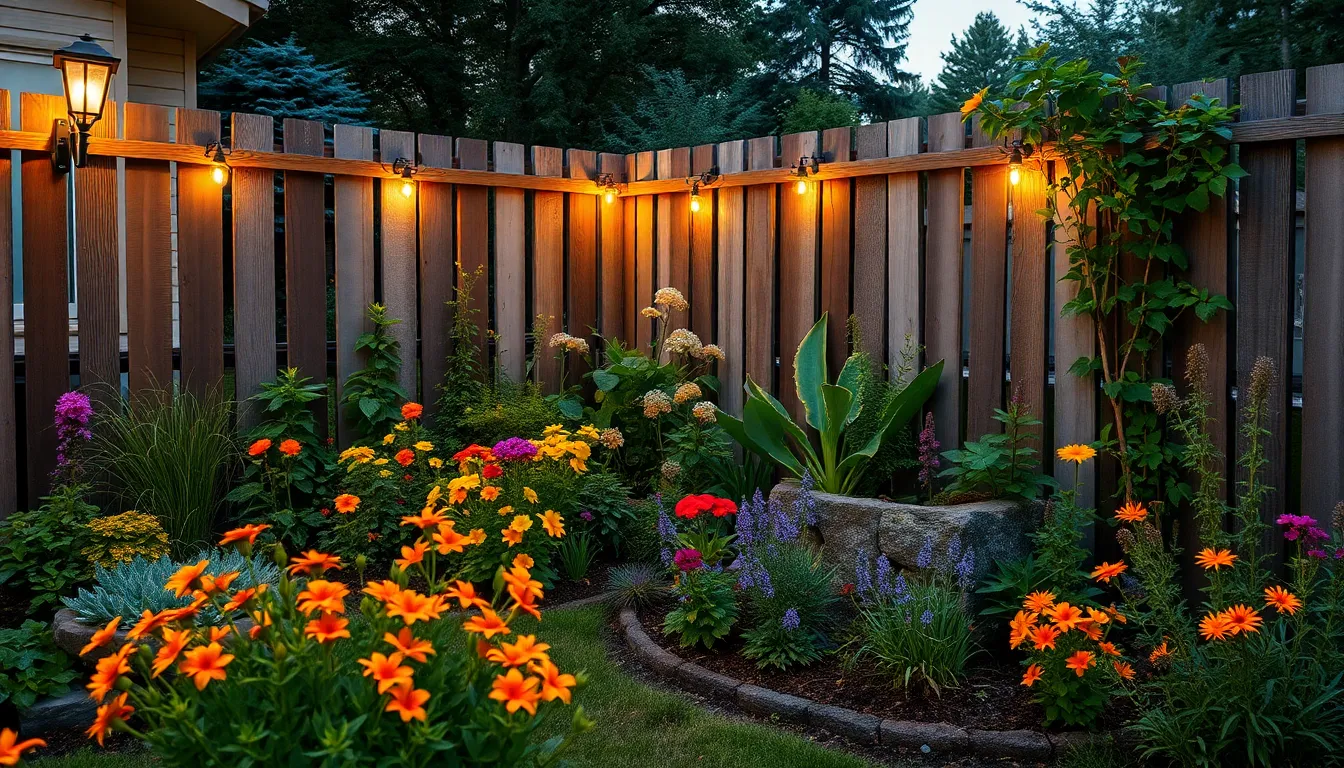
Creating beautiful front garden boundaries doesn’t mean compromising our environmental values. Sustainable fencing choices combine aesthetic appeal with ecological responsibility while often providing long term cost savings.
Recycled Material Choices
Pallet wood repurposing transforms discarded shipping materials into charming rustic barriers that reduce waste while creating unique fence designs. We can sand weathered pallets to reveal beautiful wood grain patterns and arrange them vertically or horizontally for different visual effects.
Reclaimed wood fencing conserves natural resources by giving new life to materials from old barns, decks, or buildings. These materials often feature rich patina and character marks that add instant charm to front garden boundaries.
Repurposed metal items create durable fence sections using old corrugated sheets, vintage gates, or salvaged industrial materials. Steel components resist weather damage for decades while providing interesting textural contrasts in modern industry designs.
Recycled plastic lumber offers wood like appearance without forest impact, utilizing thousands of plastic bottles in each fence panel. These materials resist moisture, insects, and UV damage while requiring zero maintenance treatments over their lifespan.
Solar-Powered Lighting Integration
Solar fence post caps eliminate electrical wiring costs while providing gentle illumination along fence lines throughout the night. These energy efficient fixtures charge during daylight hours and automatically activate at dusk for enhanced security and visibility.
Integrated solar strip lighting mounts along fence rails to create continuous ambient lighting that highlights landscaping features. We can choose warm white or color changing LED options that consume zero grid electricity while adding dramatic curb appeal.
Motion activated solar spotlights mount on fence posts to provide bright security lighting when movement is detected. These systems deter unwanted visitors while conserving battery power through intelligent sensor technology.
Solar string light attachments create festive atmospheres for outdoor entertaining while maintaining eco friendly operation. Weather resistant designs withstand seasonal changes and provide years of maintenance free illumination.
Native Plant Combination Strategies
Living fence integration combines bamboo or reed panels with indigenous plant varieties that support local wildlife and network health. We select plants that attract beneficial insects, birds, and pollinators while creating natural privacy screens.
Native shrub borders work alongside fencing materials to create layered boundaries that change beautifully through seasons. Plants like native azaleas, elderberry, or serviceberry provide flowers, berries, and shelter for wildlife.
Climbing vine support systems use fence structures to grow native honeysuckle, wild grape, or Virginia creeper for additional privacy coverage. These plants absorb carbon dioxide while creating habitat corridors for small animals and insects.
Pollinator garden strips along fence bases feature native wildflowers and grasses that require minimal water and maintenance. Species selection based on local growing conditions ensures successful establishment and long term sustainability.
Conclusion
We’ve explored countless options to transform your front garden’s entrance from simple wooden pickets to sophisticated metal panels and living hedges. Each fencing style offers unique benefits whether you’re seeking privacy security or pure aesthetic appeal.
The key lies in matching your fence choice to your home’s architecture budget and maintenance preferences. Natural materials like stone and wood provide timeless elegance while composite and vinyl options deliver durability with minimal upkeep.
Remember to check local regulations before starting your project and consider how your fence will evolve with your industry over time. With proper planning your front garden fence will enhance your property’s value and curb appeal for years to come.
Frequently Asked Questions
What are the best materials for front garden fencing?
The best materials depend on your budget and style preferences. Cedar offers excellent durability and natural resistance to weather, while aluminum provides lightweight, corrosion-resistant modern appeal. Composite and vinyl materials require minimal maintenance and resist rot and insects. For budget-conscious homeowners, pine wood and recycled materials like pallet wood offer affordable alternatives.
How tall should a front yard fence be?
Most communities limit front yard fencing to 3-4 feet in height to maintain neighborhood visibility and curb appeal. This height effectively defines property boundaries while complying with local zoning regulations. Always check your local building codes and HOA requirements before installation, as height restrictions vary by location and may require permits.
What’s the difference between picket and panel fencing?
Picket fencing features individual vertical slats with spaces between them, creating a classic, open appearance that maintains visibility. Panel fencing consists of solid sections that provide more privacy and security. Picket fences are ideal for decorative boundaries, while panels work better when privacy is the primary concern.
How much maintenance do wooden fences require?
Wooden fences typically need staining or painting every 2-3 years to protect against weather damage. Cedar requires less maintenance than pine due to its natural resistance properties. Regular cleaning, checking for loose boards, and treating any damage promptly will extend your fence’s lifespan and maintain its appearance.
Are living fences a good alternative to traditional fencing?
Living fences using hedges and shrubs offer natural beauty that improves over time while supporting local wildlife. Evergreen varieties like boxwood provide year-round coverage, while flowering shrubs add seasonal color. However, they require regular trimming and take time to establish, making them ideal for patient homeowners seeking eco-friendly solutions.
What permits do I need for front yard fencing?
Permit requirements vary by location, but most areas require permits for fences over a certain height (typically 3-4 feet in front yards). Contact your local building department and check HOA regulations before starting your project. Some areas also require neighbor notification or approval for shared property line fences.
How can I make my fence more eco-friendly?
Choose recycled materials like reclaimed wood or recycled plastic lumber, which reduce environmental impact. Incorporate native plants that support local wildlife, use solar-powered lighting for illumination, and consider bamboo for sustainable screening. Repurposing materials like old pallets also creates unique, environmentally conscious fencing solutions.
What’s the most cost-effective DIY fencing option?
Pallet wood repurposing offers the most budget-friendly DIY option, often costing just the price of hardware and tools. Chain link and vinyl fencing from hardware stores provide affordable alternatives with easy installation. Bamboo rolls offer sustainable, inexpensive screening that’s simple to install for temporary or permanent boundaries.
